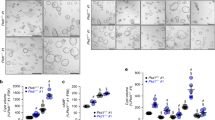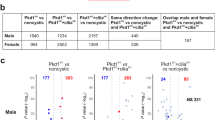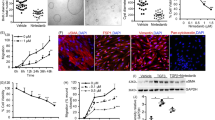Abstract
Polycystic kidney disease (PKD) represents a family of genetic disorders characterized by renal cystic growth and progression to kidney failure1. No treatment is currently available for people with PKD, although possible therapeutic interventions are emerging2,3,4,5,6,7,8. Despite genetic and clinical heterogeneity, PKDs have in common defects of cystic epithelia, including increased proliferation, apoptosis and activation of growth regulatory pathways1. Sphingolipids and glycosphingolipids are emerging as major regulators of these cellular processes9. We sought to evaluate the therapeutic potential for glycosphingolipid modulation as a new approach to treat PKD. Here we demonstrate that kidney glucosylceramide (GlcCer) and ganglioside GM3 levels are higher in human and mouse PKD tissue as compared to normal tissue, regardless of the causative mutation. Blockade of GlcCer accumulation with the GlcCer synthase inhibitor Genz-123346 effectively inhibits cystogenesis in mouse models orthologous to human autosomal dominant PKD (Pkd1 conditional knockout mice) and nephronophthisis (jck and pcy mice). Molecular analysis in vitro and in vivo indicates that Genz-123346 acts through inhibition of the two key pathways dysregulated in PKD: Akt protein kinase–mammalian target of rapamycin signaling and cell cycle machinery. Taken together, our data suggest that inhibition of GlcCer synthesis represents a new and effective treatment option for PKD.
This is a preview of subscription content, access via your institution
Access options
Subscribe to this journal
Receive 12 print issues and online access
$209.00 per year
only $17.42 per issue
Buy this article
- Purchase on Springer Link
- Instant access to full article PDF
Prices may be subject to local taxes which are calculated during checkout




Similar content being viewed by others
References
Torres, V.E. & Harris, P.C. Autosomal dominant polycystic kidney disease: the last 3 years. Kidney Int. 76, 149–168 (2009).
Bukanov, N.O., Smith, L.A., Klinger, K.W., Ledbetter, S.R. & Ibraghimov-Beskrovnaya, O. Long-lasting arrest of murine polycystic kidney disease with CDK inhibitor roscovitine. Nature 444, 949–952 (2006).
Tao, Y., Kim, J., Schrier, R.W. & Edelstein, C.L. Rapamycin markedly slows disease progression in a rat model of polycystic kidney disease. J. Am. Soc. Nephrol. 16, 46–51 (2005).
Leuenroth, S.J., Bencivenga, N., Chahboune, H., Hyder, F. & Crews, C.M. Triptolide reduces cyst formation in a neonatal to adult transition Pkd1 model of ADPKD. Nephrol. Dial Transplant. published online, doi:10.1093/ndt/gfp777 (4 February 2010).
Gattone, V.H. II, Wang, X., Harris, P.C. & Torres, V.E. Inhibition of renal cystic disease development and progression by a vasopressin V2 receptor antagonist. Nat. Med. 9, 1323–1326 (2003).
Ruggenenti, P. et al. Safety and efficacy of long-acting somatostatin treatment in autosomal-dominant polycystic kidney disease. Kidney Int. 68, 206–216 (2005).
Wahl, P.R. et al. Inhibition of mTOR with sirolimus slows disease progression in Han:SPRD rats with autosomal dominant polycystic kidney disease (ADPKD). Nephrol. Dial. Transplant. 21, 598–604 (2006).
Shillingford, J.M., Piontek, K.B., Germino, G.G. & Weimbs, T. Rapamycin ameliorates PKD resulting from conditional inactivation of Pkd1. J. Am. Soc. Nephrol. 21, 489–497 (2010).
Bieberich, E. Integration of glycosphingolipid metabolism and cell-fate decisions in cancer and stem cells: review and hypothesis. Glycoconj. J. 21, 315–327 (2004).
Gabow, P.A. Autosomal dominant polycystic kidney disease. N. Engl. J. Med. 329, 332–342 (1993).
Igarashi, P. & Somlo, S. Genetics and pathogenesis of polycystic kidney disease. J. Am. Soc. Nephrol. 13, 2384–2398 (2002).
Hildebrandt, F., Attanasio, M. & Otto, E. Nephronophthisis: disease mechanisms of a ciliopathy. J. Am. Soc. Nephrol. 20, 23–35 (2009).
Quarmby, L.M. & Parker, J.D. Cilia and the cell cycle? J. Cell Biol. 169, 707–710 (2005).
Simons, M. et al. Inversin, the gene product mutated in nephronophthisis type II, functions as a molecular switch between Wnt signaling pathways. Nat. Genet. 37, 537–543 (2005).
Yamaguchi, T. et al. Calcium restriction allows cAMP activation of the B-Raf/ERK pathway, switching cells to a cAMP-dependent growth-stimulated phenotype. J. Biol. Chem. 279, 40419–40430 (2004).
Wahl, P.R. et al. Mitotic activation of Akt signalling pathway in Han:SPRD rats with polycystic kidney disease. Nephrology (Carlton) 12, 357–363 (2007).
Masoumi, A., Reed-Gitomer, B., Kelleher, C. & Schrier, R.W. Potential pharmacological interventions in polycystic kidney disease. Drugs 67, 2495–2510 (2007).
Lahiri, S. & Futerman, A.H. The metabolism and function of sphingolipids and glycosphingolipids. Cell. Mol. Life Sci. 64, 2270–2284 (2007).
Chatterjee, S., Shi, W.Y., Wilson, P. & Mazumdar, A. Role of lactosylceramide and MAP kinase in the proliferation of proximal tubular cells in human polycystic kidney disease. J. Lipid Res. 37, 1334–1344 (1996).
Rani, C.S. et al. Cell cycle arrest induced by an inhibitor of glucosylceramide synthase. Correlation with cyclin-dependent kinases. J. Biol. Chem. 270, 2859–2867 (1995).
Cuvillier, O. et al. Suppression of ceramide-mediated programmed cell death by sphingosine-1-phosphate. Nature 381, 800–803 (1996).
Hong, S., Huo, H., Xu, J. & Liao, K. Insulin-like growth factor-1 receptor signaling in 3T3–L1 adipocyte differentiation requires lipid rafts but not caveolae. Cell Death Differ. 11, 714–723 (2004).
Yamashita, T. et al. Enhanced insulin sensitivity in mice lacking ganglioside GM3. Proc. Natl. Acad. Sci. USA 100, 3445–3449 (2003).
Rebbaa, A., Hurh, J., Yamamoto, H., Kersey, D.S. & Bremer, E.G. Ganglioside GM3 inhibition of EGF receptor mediated signal transduction. Glycobiology 6, 399–406 (1996).
Tagami, S. et al. Ganglioside GM3 participates in the pathological conditions of insulin resistance. J. Biol. Chem. 277, 3085–3092 (2002).
Deshmukh, G.D., Radin, N.S., Gattone, V.H. II & Shayman, J.A. Abnormalities of glycosphingolipid, sulfatide and ceramide in the polycystic (cpk/cpk) mouse. J. Lipid Res. 35, 1611–1618 (1994).
Janich, P. & Corbeil, D. GM1 and GM3 gangliosides highlight distinct lipid microdomains within the apical domain of epithelial cells. FEBS Lett. 581, 1783–1787 (2007).
Lee, L., Abe, A. & Shayman, J.A. Improved inhibitors of glucosylceramide synthase. J. Biol. Chem. 274, 14662–14669 (1999).
Abe, A. et al. Improved inhibitors of glucosylceramide synthase. J. Biochem. 111, 191–196 (1992).
Zhao, H. et al. Inhibiting glycosphingolipid synthesis improves glycemic control and insulin sensitivity in animal models of type 2 diabetes. Diabetes 56, 1210–1218 (2007).
McEachern, K.A. et al. A specific and potent inhibitor of glucosylceramide synthase for substrate inhibition therapy of Gaucher disease. Mol. Genet. Metab. 91, 259–267 (2007).
Lukina, E. et al. A phase 2 study of eliglustat tartrate (Genz-112638), an oral substrate reduction therapy for Gaucher disease type 1. Blood published online, doi:10.1182/blood-2010-03-273151 (3 May 2010).
Smith, L.A. et al. Development of polycystic kidney disease in juvenile cystic kidney mice: insights into pathogenesis, ciliary abnormalities and common features with human disease. J. Am. Soc. Nephrol. 17, 2821–2831 (2006).
Takahashi, H. et al. A hereditary model of slowly progressive polycystic kidney disease in the mouse. J. Am. Soc. Nephrol. 1, 980–989 (1991).
Otto, E.A. et al. NEK8 mutations affect ciliary and centrosomal localization and may cause nephronophthisis. J. Am. Soc. Nephrol. 19, 587–592 (2008).
Natoli, T.A. et al. Pkd1 and Nek8 mutations affect cell-cell adhesion and cilia in cysts formed in kidney organ cultures. Am. J. Physiol. Renal Physiol. 294, F73–F83 (2008).
Shayman, J.A. et al. Modulation of renal epithelial cell growth by glucosylceramide. Association with protein kinase C, sphingosine, and diacylglycerol. J. Biol. Chem. 266, 22968–22974 (1991).
Seibler, J. et al. Rapid generation of inducible mouse mutants. Nucleic Acids Res. 31, e12 (2003).
Folch, J., Lees, M. & Sloane Stanley, G.H. A simple method for the isolation and purification of total lipides from animal tissues. J. Biol. Chem. 226, 497–509 (1957).
Jankowski, K. Microdetermination of phosphorus in organic materials from polymer industry by microwave-induced plasma atomic emission spectrometry after microwave digestion. Microchem. J. 70, 41–49 (2001).
Acknowledgements
We thank V. Gattone (Indiana University School of Medicine) for the kind gift of pcy breeding pairs and advice on colony maintenance. We thank S. Jones and the staff of Rodent Experimental Models (Worcester, Massachusetts) for production of the Pkd1 conditional knockout mice. We thank the staff of the Genzyme Departments of Comparative Medicine and Histology for help with in vivo studies and sample preparations. We thank S. Moreno for expert technical assistance. We are grateful to K. McEachern, R. Sacchiero, D. Copeland, S. Cheng, N. Yew, A. Smith, R. Gregory, T. Sybertz, K. Klinger and J. Burns for helpful discussions and comments on this manuscript.
Author information
Authors and Affiliations
Contributions
T.A.N. designed, conducted and analyzed the in vivo data. T.A.N., L.A.S. and K.A.R. performed the in vivo work. B.W., S.K., Y.B., A.B. and W.R.D. performed the glycosphingolipid analyses. K.A.R., W.R.D., N.O.B. and H.H. performed image processing and histological quantification. H.H. and R.J.R. performed and analyzed the in vitro work. J.A.S., S.R.L. and J.P.L. provided scientific advice, data analysis and edited the manuscript. T.A.N. and O.I.-B. wrote the manuscript, with contributions from K.A.R., N.O.B. and H.H. O.I.-B. designed experiments, analyzed results and supervised the project.
Corresponding author
Ethics declarations
Competing interests
T.A.N., L.A.S., K.A.R., B.W., S.K., Y.B., A.B., N.O.B., W.R.D., H.H., R.J.R., S.R.L., J.P.L. and O. I.-B. are all employed by Genzyme. J.A.S. holds intellectual property rights for Genzyme.
Supplementary information
Supplementary Text and Figures
Supplementary Figures 1–3, Supplementary Tables 1–3 and Supplementary Methods (PDF 2258 kb)
Rights and permissions
About this article
Cite this article
Natoli, T., Smith, L., Rogers, K. et al. Inhibition of glucosylceramide accumulation results in effective blockade of polycystic kidney disease in mouse models. Nat Med 16, 788–792 (2010). https://doi.org/10.1038/nm.2171
Received:
Accepted:
Published:
Issue Date:
DOI: https://doi.org/10.1038/nm.2171
This article is cited by
-
Glucose absorption drives cystogenesis in a human organoid-on-chip model of polycystic kidney disease
Nature Communications (2022)
-
Drugs in Clinical Development to Treat Autosomal Dominant Polycystic Kidney Disease
Drugs (2022)
-
Therapeutic advances in ADPKD: the future awaits
Journal of Nephrology (2022)
-
Parapelvic Cysts: An Imaging Marker of Kidney Disease Potentially Leading to the Diagnosis of Treatable Rare Genetic Disorders? A Narrative Review of the Literature
Journal of Nephrology (2022)
-
Changing the Outcome of a Pediatric Disease: Part II — Current Treatment Options in ADPKD
Current Treatment Options in Pediatrics (2022)



